David Crosby
Song: “Orleans”
Album: If I Could Only Remember My Name
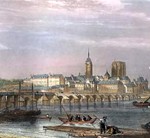 The title of the song actually is LE CARILLON DE VENDÔME or LES CLOCHES DE VENDÔME and it still is in France a short children’s song that kids learn in primary school. It dates back to the 15th century and is the oldest known French song. The actual melody was the one played by the “carillon” or chimes in the church towers of the cities of Vendôme and Beaugency (see photo).
The title of the song actually is LE CARILLON DE VENDÔME or LES CLOCHES DE VENDÔME and it still is in France a short children’s song that kids learn in primary school. It dates back to the 15th century and is the oldest known French song. The actual melody was the one played by the “carillon” or chimes in the church towers of the cities of Vendôme and Beaugency (see photo).
Orléans, Beaugency, Notre-Dame de Cléry (bis)
Vendôme, Vendôme
Quel chagrin, quel ennui, de compter toutes les heures
Quel chagrin, quel ennui, de compter jusqu’à minuit
Orléans, Beaugency, Notre-Dame de Cléry (bis)
Vendôme, Vendôme
Original version:
Mes amis que reste-t-il (My friends what is left)
À ce Dauphin si gentil? (To this “Dauphin” so gentle?)
Orléans, Beaugency
Notre-Dame de Cléry
Vendôme, Vendôme.
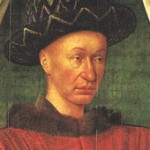 The song “Orléans” takes us back to the period of The Hundred Years’ War which was a conflict between England and France, lasting 116 years from 1337 to 1453. The Dauphin was Charles VII, and during the war, he was out of Paris. The kingdome of France was reduced to a small area and these were the cities he was still controlling: Orléans, Beaugency, Cléry, Vendôme. In memory of this time the chimes of the churches of Beaugency and Vendôme, which were faithful to the king, play “Orléans” three times per day.
The song “Orléans” takes us back to the period of The Hundred Years’ War which was a conflict between England and France, lasting 116 years from 1337 to 1453. The Dauphin was Charles VII, and during the war, he was out of Paris. The kingdome of France was reduced to a small area and these were the cities he was still controlling: Orléans, Beaugency, Cléry, Vendôme. In memory of this time the chimes of the churches of Beaugency and Vendôme, which were faithful to the king, play “Orléans” three times per day.
David Crosby: “I learned that from Paul Kantner around this time. It’s a French children’s song, and it’s a series of names of cathedrals in France. I loved the guitar thing I did after it, the little picking melody that follows the vocal. It was two six-strings, and I played ‘em both-that’s the Mormon Tabernacle Dave.”
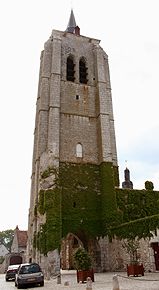 Stephen Barncard: “I think it’s the first thing we recorded. David started with a single guitar, then a second, then did all the voices, one after the other. He had the various parts in his head for years but it all came together in one evening. We started at 19:00hr and were done with a rough mix on cassette for the boat by 23:00.
Stephen Barncard: “I think it’s the first thing we recorded. David started with a single guitar, then a second, then did all the voices, one after the other. He had the various parts in his head for years but it all came together in one evening. We started at 19:00hr and were done with a rough mix on cassette for the boat by 23:00.
The cassettes really helped put the record together; we would do a rough mix of everything and he would take the then new cassette tape to his boat for review. He had a cute little stereo Sony with detachable speakers that he listened to all day on the boat, and could come up with lyrics and harmony lines to sing at night.
This was from our very first day in the studio together, just me and Dave. The others would come to hang out later.”
The city of Beaugency has experienced a sometimes violent military history. It was occupied on four separate occasions by the English. On June 16 – 17, 1429, it was the site of the famous Battle of Beaugency, when it was finally freed by Joan of Arc (also known as Jeanne d’Arc). Beaugency also played an important strategic role in the Hundred Years’ War. It was burned by the protestants in 1567 and suffered extensive damage to the walls, the castle, and the church. In 1940 and again in 1944 the city was bombed by Nazi Germany.
The Saint-Firmin church tower in Beaugency is the last remnant of a Roman church from the 11th century altered during the Renaissance and demolished at the time of the revolution. The building originally occupied the square of Saint-Firmin as we see it today. Three times a day the famous 15th chimes “Orléans, Beaugency, Notre -Dame de Cléry, Vendôme” can be heard.
Stephen Stills
Song: “Johnny’s Garden”
Album: Manassas
The song officially saw the first light of day on Manassas, a double album released in April 1972. The band, which many people consider to be the finest that Stephen Stills has ever assembled, featured Chris Hillman on guitar and vocals, Dallas Taylor on drums, Paul Harris on keyboards, Calvin “Fuzzy” Samuels on bass, the mighty Al Perkins on pedal steel guitar and Joe Lala on percussion. Stephen lived up to his nickname of “Captain Manyhands” in playing electric and acoustic guitar as well as bottleneck guitar and keyboards.

Left to right: Peter Sellers, Johnny and Stephen Stills at Elstead in Surrey. Photo by Henry Diltz.
Running through the album was the theme of unrequited love for Judy Collins who really was Stephen’s muse and soulmate. This is illustrated especially well in the lyrics to “Colorado” as well as featuring in “Johnny’s Garden” where Stills talks of being “safe from the city blues” and finding a place that is “green and quiet” He found solace from his broken heart in England, and especially in the garden of the house in Elstead, Surrey.
Brookfield House in Elstead, Surrey was owned by the actor Spencer Tracy, then Peter Sellers who sold it on to Ringo Starr. Stephen Stills purchased the house, a 350 year old Tudor mansion, for £100000 in 1970 and in his own words “had the most wonderful bursts of creativity there”. Today’s market value of the property would be in the region of 10 times the 1970 price.
Brookfield House in Elstead, Surrey was owned by the actor Spencer Tracy, then Peter Sellers who sold it on to Ringo Starr. Stephen Stills purchased the house, a 350 year old Tudor mansion, for £100000 in 1970 and in his own words “had the most wonderful bursts of creativity there”. Today’s market value of the property would be in the region of 10 times the 1970 price.
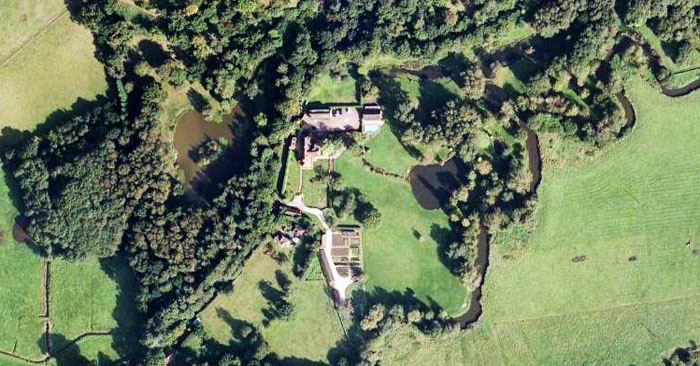
The one constant in all the changes of ownership was Johnny the gardener, who kept the estate looking immaculate, “He had soul” explained Stephen. “He was a herbalist and use to make the most incredible herbal teas. The song was written at a time when I was on the road constantly, and what I really needed was to stay at home and tend my garden.” Stills writes that the place is his refuge from the excesses of the rock and roll business, but he also realises that his chosen way of life has allowed him to purchase this retreat – “only trouble was I had to buy it.”
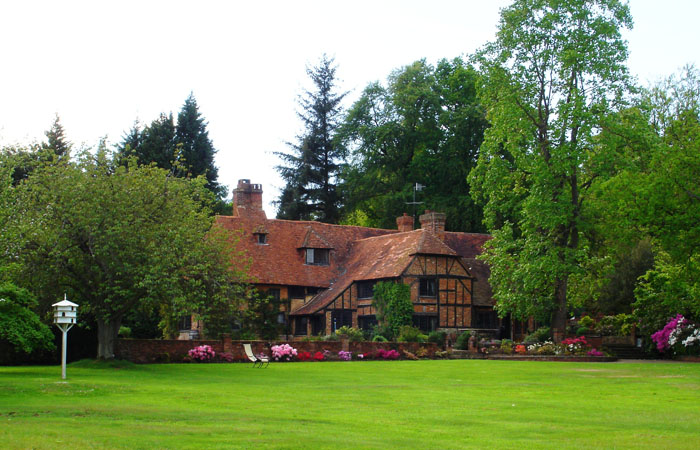
As a footnote, it is said that Peter Sellers based his part of Chauncey (the gardener in the film Being There) on Johnny the gardener.
There’s a place I can get to
Where I’m safe from the city blues
And it’s green and it’s quiet
Only trouble was, I had to buy it
And I’ll do anything I’ve got to do
Cut my hair and shine my shoes
And keep on singin’ the blues
If I can stay here in Johnny’s garden
As the swift bird flies over the grasses
Dipping now and then to take his breakfast
Thus I come and go and I travel
And I can watch that bird and unravel
And I’ll do anything I’ve got to do
Cut my hair and shine my shoes
And keep on singin’ the blues
If I can stay here in Johnny’s garden
With his love and his caring
He puts his life into beauty sharing
And his children are his flowers
There to give us peace in quiet hours
And I’ll do anything I’ve got to do
Cut my hair and shine my shoes
And keep on singin’ the blues
If I can stay here in Johnny’s garden.
Resources:
Rhino.com website for photograph
The Complete Guide To The Music Of CSN – Johnny Rogan
CSN – The Authorised Biography” – Dave Zimmer
Lyrics copyright Gold Hill Music BMI
Graham Nash
Song: “Cathedral”
Album: CSN
“Cathedral,” with its musical crescendo from Nash’s solo piano to a propulsive, churning CSN-fired chorus, and a torrent of emotional takes on religion and being in Winchester Cathedral on acid, is, without question, one of Nash’s most stirring songs.
Find out what the real date of “that soldier that died in 1799″ was…
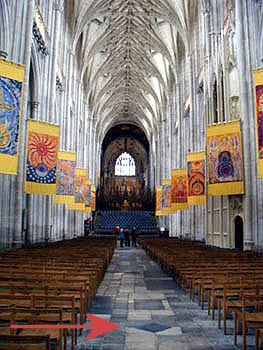 In Nash’s own words, spinning back to the early ’70s: “The incident was: getting up in the morning at 6:00, getting in this old Rolls-Royce that we’d hired for the day, going over to this dealer’s in London and picking up some acid, dropping the acid and then going through Richmond Park with the ultimate goal of ending up in Stonehenge — and we went through Winchester on the way.
In Nash’s own words, spinning back to the early ’70s: “The incident was: getting up in the morning at 6:00, getting in this old Rolls-Royce that we’d hired for the day, going over to this dealer’s in London and picking up some acid, dropping the acid and then going through Richmond Park with the ultimate goal of ending up in Stonehenge — and we went through Winchester on the way.
We were with (former CSNY road manager) Leo Makota and another friend. And the experience in Winchester Cathedral was probably my favorite acid trip I’ve taken — I haven’t taken that many, perhaps a couple dozen. It was an amazing space — the feeling of the sunlight pouring in through the windows, in fact, when the sunlight hits, it definitely made a *bbhhrr* sound, the pillars turn to ivory white. So much feeling inside it, I’m sure I didn’t need the acid. I was walking down the aisle, one of the aisles, there were graves on the floor and one of them attracted my attention and my legs started to waver, not shake, but just waver, you know, like a divining rod — it was real strange. I looked down and this guy had died on February 2nd [Nash’s birthday] in, I think the actual date was 1798, but poetic license made in 1799 for the rhyme scheme. And it was very interesting, that I would be attracted to a thing I hadn’t seen, with my eyes six feet above the ground…”
The gravestone can be seen on this photo, but the story is still unfolding…!
However… according to findagrave.com, Nash explained in an (probably recent) interview: “I was once walking down the central aisle of Winchester Cathedral and felt a presence at my feet. I happened to be standing on the grave of Hugh Foulkes, a soldier who died in 1799″.
So the year is 1799! Check the picture below and use your own judgment.
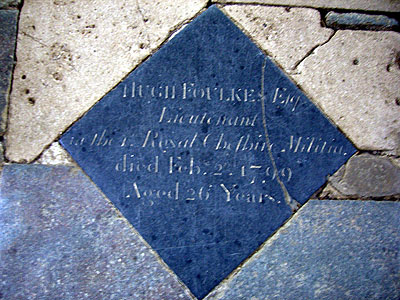
“Hugh Foulkes, Esq., Lieutenant in the Royal Cheshire Militia, died Febr. 2nd. 1799, aged 26 years”. A soldier who died in… 1799!
In 2007 Nash says (after this section was updated) to 4waysite.com, the original date is 1799 indeed: “In my ‘highness’ I thought that the date was 1798 and that did not rhyme, so…. 1799! Then I find out that I was right all along… a pleasant surprise, Graham.”
Nash also admits that the eventual “Cathedral” songwriting process “Was the longest one for me. It took about four years. After the experience, I began to write a piece of music with no lyrics and that was the *feeling* of what it was I wanted to say. But trying to hone down the overwhelming series of feelings I had into some cohesive form, understandable to other people, was a long process”.
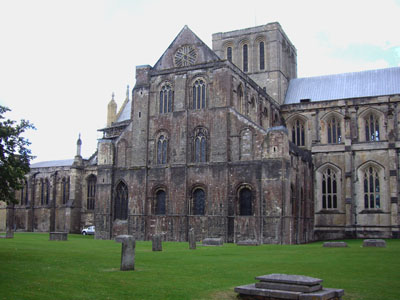 Winchester Cathedral at Winchester in Hampshire is one of the largest cathedrals in England, said to be the second longest, and with the longest nave, in Europe. It is dedicated to the Holy Trinity, Saint Peter, Saint Paul and Saint Swithun and is the seat of the Bishop of Winchester and centre of the Diocese of Winchester.
Winchester Cathedral at Winchester in Hampshire is one of the largest cathedrals in England, said to be the second longest, and with the longest nave, in Europe. It is dedicated to the Holy Trinity, Saint Peter, Saint Paul and Saint Swithun and is the seat of the Bishop of Winchester and centre of the Diocese of Winchester.
The cathedral was originally founded in 642 on an immediately adjoining site to the north. This building was known as the Old Minster. It became part of a monastic settlement in 971. Saint Swithun was buried near the Old Minster and then in it, before being moved to the new Norman cathedral. Mortuary chests said to contain the remains of Saxon kings such as King Edwy of England and his wife Queen Elgiva, first buried in the Old Minster, are also housed in the present cathedral. The Old Minster was demolished in 1093.
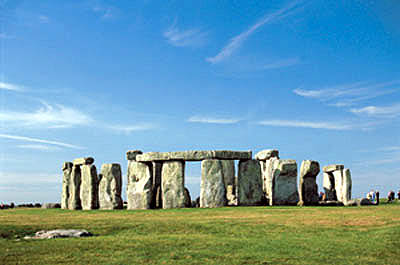 Stonehenge is a prehistoric monument located in the English county of Wiltshire, about 8 miles (13 km) north of Salisbury. One of the most famous prehistoric sites in the world, Stonehenge is composed of earthworks surrounding a circular setting of large standing stones. Archaeologists believe the standing stones were erected around 2200 BC and the surrounding circular earth bank and ditch, which constitute the earliest phase of the monument, have been dated to about 3100 BC.
Stonehenge is a prehistoric monument located in the English county of Wiltshire, about 8 miles (13 km) north of Salisbury. One of the most famous prehistoric sites in the world, Stonehenge is composed of earthworks surrounding a circular setting of large standing stones. Archaeologists believe the standing stones were erected around 2200 BC and the surrounding circular earth bank and ditch, which constitute the earliest phase of the monument, have been dated to about 3100 BC.
The site and its surroundings were added to the UNESCO’s list of World Heritage Sites in 1986 in a co-listing with Avebury henge monument, and it is also a legally protected Scheduled Ancient Monument. Stonehenge itself is owned and managed by English Heritage while the surrounding land is owned by the National Trust.
Words & Music – Graham Nash
copyright 1977, Thin Ice Music, ASCAP.
Six o’ clock
In the morning, I feel pretty good
So I dropped into the luxury of the Lords
Fighting dragons and crossing swords
With the people against the hordes
Who came to conquer.
Seven o’clock
In the morning, here it comes
I taste the warning and I am so amazed
I’m here today, seeing things so clear this way
In the car and on my way
To Stonehenge.
I’m flying in Winchester cathedral
Sunlight pouring through the break of day.
Stumbled through the door and into the chamber;
There’s a lady setting flowers on a table covered lace
And a cleaner in the distance finds a cobweb on a face
And a feeling deep inside of me tells me
This can’t be the place
I’m flying in Winchester cathedral.
All religion has to have its day
Expressions on the face of the Saviour
Made me say
I can’t stay.
Open up the gates of the church and let me out of here!
Too many people have lied in the name of Christ
For anyone to heed the call.
So many people have died in the name of Christ
That I can’t believe it all.
And now I’m standing on the grave of a soldier that died in 1799
And the day he died it was a birthday
And I noticed it was mine.
And my head didn’t know just who I was
And I went spinning back in time.
And I am high upon the altar
High upon the altar, high.
I’m flying in Winchester cathedral,
It’s hard enough to drink the wine.
The air inside just hangs in delusion,
But given time,
I’ll be fine.
Crosby, Stills, Nash – Vocals
Graham Nash – Piano
Joe Vitale – Drums, Timpani, Percussion
George Perry – Bass
Mike Lewis, David Crosby, Graham Nash & Joel Bernstein – String Arrangements
![]()
Song: “Ohio”
Album: single (1970), 4 Way Street and So Far
“Ohio” is a protest song performed by CSNY and written by Neil Young in reaction to the Kent State shootings of May 4, 1970. It was first released as a single, peaking at #14 on the Billboard Hot 100.
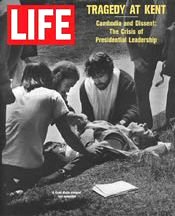 Neil Young wrote the lyrics to “Ohio” after seeing the photos of the incident in Life magazine. On the evening that CSNY entered Record Plant Studios in New York City, the song had already been rehearsed, and the quartet with their regular rhythm section recorded it live in just a few takes. During the same session they recorded the song’s equally direct b-side, Stephen Stills’ ode to the war’s dead “Find the Cost of Freedom.” Like its companion, the Stills track was cut live, the four voices blending to the accompaniment of only Stills’ guitar.
Neil Young wrote the lyrics to “Ohio” after seeing the photos of the incident in Life magazine. On the evening that CSNY entered Record Plant Studios in New York City, the song had already been rehearsed, and the quartet with their regular rhythm section recorded it live in just a few takes. During the same session they recorded the song’s equally direct b-side, Stephen Stills’ ode to the war’s dead “Find the Cost of Freedom.” Like its companion, the Stills track was cut live, the four voices blending to the accompaniment of only Stills’ guitar.
On May fourth of 1970, four days of tension between Anti-War demonstrators at Kent State University and government officials climaxed when members of the Ohio National Guard fired a volley of some 67 shots in a thirteen second time period that would leave four dead, nine injured and a nation forever changed.
The students were protesting the American invasion of Cambodia which President Richard Nixon launched on April 25, and announced in a television address five days later.
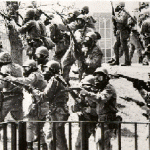 While on the practice field, the guardsmen generally faced the parking lot which was about 100 meters away. At one point some of the guardsmen kneeled and aimed their weapons toward the parking lot, then stood up again. For a few moments several guardsmen formed a loose huddle and appeared to be talking to one another. The guardsmen appeared to be unclear as to what to do next. They had cleared the protestors from The Commons area, and many students had left, but many stayed and were still angrily confronting the soldiers, some throwing rocks and tear gas canisters. At the end of about ten minutes the Guardsmen began to retrace their steps back up the hill toward The Commons area. Some of the students on the Taylor Hall veranda began to move slowly toward the soldiers as the latter passed over the top of the hill and headed back down into The Commons.
While on the practice field, the guardsmen generally faced the parking lot which was about 100 meters away. At one point some of the guardsmen kneeled and aimed their weapons toward the parking lot, then stood up again. For a few moments several guardsmen formed a loose huddle and appeared to be talking to one another. The guardsmen appeared to be unclear as to what to do next. They had cleared the protestors from The Commons area, and many students had left, but many stayed and were still angrily confronting the soldiers, some throwing rocks and tear gas canisters. At the end of about ten minutes the Guardsmen began to retrace their steps back up the hill toward The Commons area. Some of the students on the Taylor Hall veranda began to move slowly toward the soldiers as the latter passed over the top of the hill and headed back down into The Commons.
At this point, a number of guardsmen at the top of the hill abruptly turned and fired into the students. The guardsmen directed their fire not at the closest students, who were on the Taylor Hall veranda, but at those on the grass area and concrete walkway below the veranda, at those on the service road between the veranda and the parking lot, and at those in the parking lot. Bullets were not sprayed in all directions, but instead were confined to a fairly limited line of fire leading from the top of the hill to the parking lot. Not all the soldiers who fired their weapons directed their fire into the students. Some soldiers fired into the ground while a few fired into the air. In all, 29 of the 77 guardsmen fired their weapons. A total of 67 bullets were fired. The shooting was determined to have lasted only thirteen seconds, although a New York Times reporter stated that “it appeared to go on, as a solid volley, for perhaps a full minute or a little longer.” The question of why the shots were fired is widely debated. The Adjutant General of the Ohio National Guard told reporters that a sniper had fired on the guardsmen, which itself remains a debated allegation. Many guardsmen later testified that they were in fear for their lives, which was questioned partly because of the distance of the wounded students. Time magazine later concluded that “triggers were not pulled accidentally at Kent State”. The President’s Commission on Campus Unrest avoided the question of why the shootings happened, but harshly criticized both the protesters and the Guardsmen, concluding that “the indiscriminate firing of rifles into a crowd of students and the deaths that followed were unnecessary, unwarranted, and inexcusable.”
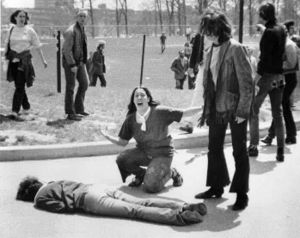 It’s this picture of a 14-year old girl named Mary Vecchio as she stands screaming over the lifeless body of victim Jeffrey Miller. For many Americans, that photograph IS the Kent State Massacre.
It’s this picture of a 14-year old girl named Mary Vecchio as she stands screaming over the lifeless body of victim Jeffrey Miller. For many Americans, that photograph IS the Kent State Massacre.
The shootings killed four students and wounded nine. Two of the four students killed, Allison Krause and Jeffrey Miller, had participated in the protest, and the other two, Sandra Scheuer and William Schroeder, were walking from one class to the next. Schroeder was also a member of the campus ROTC chapter. Of those wounded, none was closer than 71 feet (22 m) to the guardsmen. Of those killed, the nearest (Miller) was 265 feet (81 m) away.
Immediately after the shootings, many angry students were ready to launch an all-out attack on the National Guard. Many faculty members, led by geology professor and faculty marshal Glenn Frank, pleaded with the students to leave the Commons and to not give in to violent escalation. After 20 minutes of speaking, the students left the Commons, as ambulance personnel tended to the wounded, and the Guard left the area.
Tin soldiers and Nixon coming,
We’re finally on our own.
This summer I hear the drumming,
Four dead in Ohio.
Gotta get down to it
Soldiers are cutting us down [very often you read “gunning”, but that is wrong]
Should have been done long ago.
What if you knew her
And found her dead on the ground
How can you run when you know?
Gotta get down to it
Soldiers are cutting us down
Should have been done long ago.
What if you knew her
And found her dead on the ground
How can you run when you know?
Tin soldiers and Nixon coming,
We’re finally on our own.
This summer I hear the drumming,
Four dead in Ohio.
The lyrics help evoke the turbulent mood of indignation and shock in the wake of the shootings, especially the line “four dead in Ohio,” repeated throughout the song. “Tin soldiers and Nixon coming,” refers the Ohio National Guardsmen who killed the student protesters and Young’s attribution of their deaths to the President of the United States, Richard Nixon. “Should have been done long ago” echoes the sentiments of right-wing supporters of the war and their view of hippie protesters as traitors, as voiced in interviews of the time such as CBS Television’s The Common Man. Crosby once stated that Young keeping Nixon’s name in the lyrics was “the bravest thing I ever heard.” It should be noted, however, that it was Ohio Governor Rhoades who was in command of the Ohio National Guard, not President Nixon. President Nixon, in fact, condemned the shootings.
On June 13, 1970, President Nixon established the President’s Commission on Campus Unrest, known as the Scranton Commission, which he charged to study the dissent, disorder, and violence breaking out on college and university campuses across the nation. The Commission’s establishment was a consequence of the killings of protesting students at Kent State and Jackson State. The Commission issued its findings in a September 1970 report that concluded that the Ohio National Guard shootings on May 4, 1970 were unjustified.
After the double’s release, it was banned from some AM radio stations because of the challenge to the Nixon Administration in the lyrics, but received airplay on then underground FM stations in larger cities and college towns. The American counterculture took the group as its own after this song, giving the four a status as leaders and spokesmen they would enjoy to varying extent for the rest of the decade.
Bill Halverson: ” I’m at the studio setting up for Stephen for the evening session and I got a call from I think one of the roadies that was over at the sound stage and he said there’s been a change in plans and the band’s got this song that they wanna do together and so set up for the whole band we’re all gonna come out. They’re rehearsing it right now. They’re going to come on in a couple of hours and we’re going to record it. The mood was just very intense. I mean when they come into a room… I’ve been around those personalities for a long time, and the four of them take over a room. They are four distinct personalities and any one of the four is quite overpowering and together they’re just a joy to be with. It’s just a hoot to see them interact. And they were bent on getting it right and were on a mission. And when they’re on a mission they’re fun.”
About the B-side: ” I love the way the B-side got to be. And the B-side is ‘Find the Cost of Freedom’. While they were listening to the mix and finishing up the mix they said ‘we don’t have a B-side, we need a B-side for this.’
So they had been rehearsing also ‘Find the Cost of Freedom’ because they did that at the close of the show. So I went out and set up four chairs so they’d be knee to knee sitting facing each other and set up four vocal mics and a guitar mic for Stephen because he was gonna play guitar. Once I was set up they went out there and sat knee to knee with the four vocal mics and Stephen started playing guitar and then they started singing and sang it through. And before they could come in I rewound the tape, put it on another five tracks, and rolled it again, and they heard the guitar so they knew what was going on and waited for the vocal to come in and Stephen played along with himself, a little on guitar, played the little fills and stuff…”
NeilYoung: “It’s still hard to believe I had to write this song. It’s ironic that I capitalized on the death of these American students. Probably the most important lesson ever learned at an American place of learning. David Crosby cried after this take.”
Crosby can be heard keening “four, why? why did they die?” and “how many more?” in the fade.”
This song was also selected as the 385th Greatest Song of All Time by Rolling Stone.
Neil Young, guitar, vocal
Stephen Stills, guitars, vocal
David Crosby, guitar, vocal
Graham Nash, vocal
Calvin Samuel (yes, without ‘s’), bass (A-side only)
Johny Barbata, drums (A-side only)
Bill Halverson: engineer
